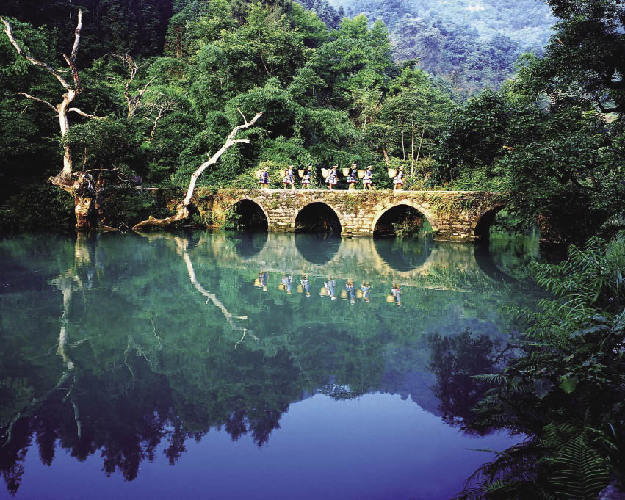Qiannan Prefecture
– The Land That Time Forgot
By WU MEILING
 |
| The Xiaoqikong Scenic Spot in Libo. |
QIANNAN Bouyei and Miao Prefecture in southwestern China’s Guizhou Province boasts dual blessings from mother nature – the uncanny beauty of karst topography and primeval forests. It’s hard to say which aspect of the landscape is more arresting – the wild Avatar-esque alienness of the vertiginous peaks, or the forests, which have sustained an ecosystem brimming with life for millennia upon millennia. For tourists, the question is moot; both can be appreciated in equal measure on short trips from the prefectural capital of Duyun.
Libo, a Legacy of History
A 2005 poll by Chinese National Geography magazine voted the karst scenery in Libo, Qiannan Prefecture, the No. 8 most fascinating such formation in China. That’s quite an achievement, considering Libo is way off the beaten tourist trail, and the other top 10 place-getters are overtly commercialized.
Karst topography is the geological phenomenon created by the dissolution of one or many layers of soluble bedrock. It is named after the Kras plateau region of eastern Italy and western Slovenia (Kras is German for “barren land”). The landscape on most karst terrains is rocky and barren, with a thin layer of soil to support vegetation. In Guizhou’s Libo, however, the situation is very different: the soil covering the karst landscape is rich; the area is home to 20,000 hectares of primeval forestlands.
Anyone who has the chance to view this expanse of green that rolls up and down the rugged mountain surely comes away with a different perspective on life. So few people have ventured here over the course of human history that with every step, the visitor could well be the first person ever to walk across a rock surface that has been untouched for 100 million years.
The Libo region emerged out of the sea following tectonic plate movements about 200 million years ago. As the landscape continued to develop over the following millennia, biodiversity in the area grew.
Today, the flora and fauna of Libo is unique. The ecosystem of the karst area is nonetheless extremely fragile; any major natural disaster, and especially fire, would wreak havoc. Deforestation and illegal logging is also a concern. Primeval forests are especially fragile, not just in Libo but the world over. For this reason, there are few such forests – especially in karst regions – of the scale found in Libo remaining in the world
Among Libo’s unique flora is the Kmeria septentrionalis Dandy, a dioecious tree species that was announced extinct by international scientists back in 1933, and wild Paphiopedilum emersonii, an orchid species. All in all, the region holds 1,203 floral species including 32 genera of wild orchid. It is also home to 316 species of vertebrates and 800 species of insects. More than 170 plants and animals are under top-level national protection.
Chinese botanist Qin Renchang first discovered the Kmeria septentrionalis Dandy in neighboring Guangxi Zhuang Autonomous Region in 1928, though it died out there a few years later. In 1937 the international botanical community announced the species extinct. Half a century later, however, a grove of as many as 20,000 of the trees was found deep inside Libo; many towered to a height of six to seven meters. The news caused a sensation in international biological circles. Experts were over the moon about the news of the survival of these “botanic giant pandas.”

